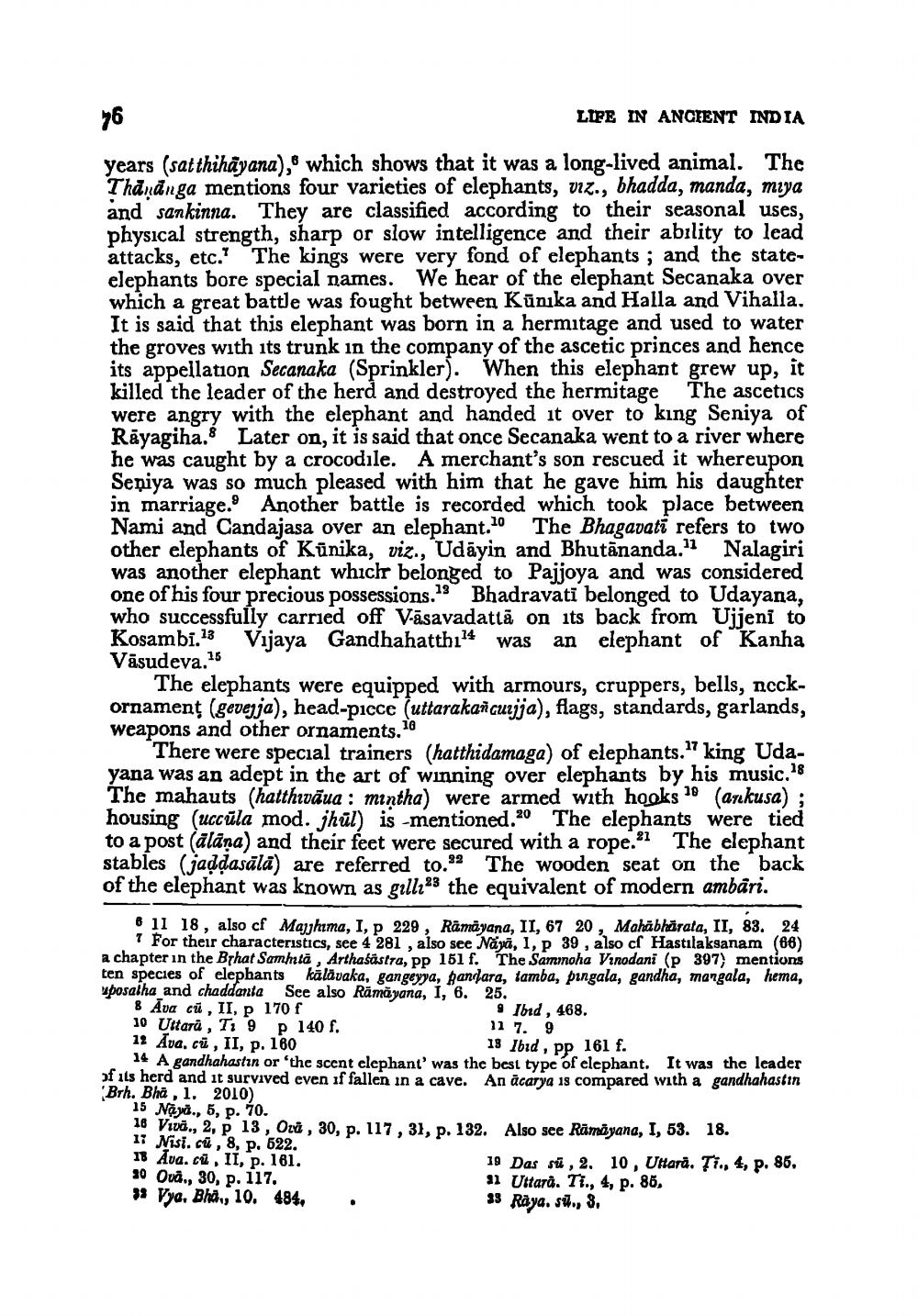________________
76
LIPE IN ANCIENT INDIA
years (satthihāyana), which shows that it was a long-lived animal. The Thànănga mentions four varieties of elephants, viz., bhadda, manda, miya and sankinna. They are classified according to their seasonal uses, physical strength, sharp or slow intelligence and their ability to lead attacks, etc. The kings were very fond of elephants; and the stateelephants bore special names. We hear of the elephant Secanaka over which a great battle was fought between Künika and Halla and Vihalla. It is said that this elephant was born in a hermitage and used to water the groves with its trunk in the company of the ascetic princes and hence its appellation Secanaka (Sprinkler). When this elephant grew up, it killed the leader of the herd and destroyed the hermitage The ascetics were angry with the elephant and handed it over to king Seniya of Rāyagiha. Later on, it is said that once Secanaka went to a river where he was caught by a crocodile. A merchant's son rescued it whereupon Seniya was so much pleased with him that he gave him his daughter in marriage. Another battle is recorded which took place between Nami and Candajasa over an elephant. The Bhagavati refers to two other elephants of Kūnika, viz., Udāyin and Bhutananda." Nalagiri was another elephant which belonged to Pajjoya and was considered one of his four precious possessions.13 Bhadravati belonged to Udayana, who successfully carried off Vāsavadattā on its back from Ujjeni to Kosambi.13 Vijaya Gandhahatth124 was an elephant of Kanha Vasudeva.15
The elephants were equipped with armours, cruppers, bells, ncckornament (gevenja), head-picce (uttarakanourija), flags, standards, garlands, weapons and other ornaments.10
There were special trainers (hatthidamaga) of elephants." king Udayana was an adept in the art of winning over elephants by his music." The mahauts (hatthrvāua : mintha) were armed with hooks 18 (arkusa) ; housing (uccula mod. jhul) is -mentioned.20 The elephants were tied to a post (alana) and their feet were secured with a rope.21 The elephant stables (jaddasāla) are referred to.32 The wooden seat on the back of the elephant was known as gillzas the equivalent of modern ambari.
6 11 18 , also cf Majhama, I, 229, Rāmāyana, II, 67 20, Mahābhārata, II, 83. 24
1 For their characteristics, see 4 281, also see Naya, 1, p 39, also cl Hastılaksanam (66) a chapter in the Brhat Samhta , Arthaśästra, pp 151 f. The Sammoha Vinodani (P 397) mentions ten species of elephants kālavaka, gangeyya, gandara, tamba, pingala, gandha, mangala, hema, posalha and chaddanta See also Rāmāyana, I, 6. 25. 8 Ava cú , II, p 170 €
9 Ibid , 468. 10 Uttara , T: 9 p 140 f.
11 7. 9 12 Ava, ci , II, p. 160
18 Ibid, pp 161 f. 14 A gandhahastın or 'the scent elephant' was the best type of elephant. It was the leader of its herd and it survived even if fallen in a cave. An acarya is compared with a gandhahaslın Brh. Bha , l. 2010)
15 Navi., 5, p. 70. 16 Vivā., 2, p 13, Ota , 30, p. 117, 31, p. 132. Also see Rāmāyana, I, 53. 18. 17 Nisi.cu, 8, p. 522. 18 Ava.cz, II, p. 161.
19 Das sú, 2, 10, UHara. Ti., 4, p. 86. 20 Ovå., 30, p. 117,
31 Uttara. Ti., 4, p. 86, 33 Vya. Bha, 10. 484,
33 Raya. s., 3.




